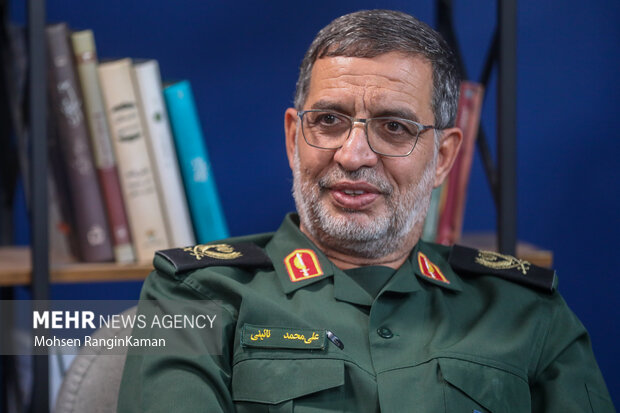Israel not dare to wage war as Iran missile power stands high

TEHRAN, Nov. 17 (MNA) – Highlighting Iran's missile power and the level of preparedness, Spokesperson of the Islamic Revolutionary Guard Corps (IRGC) asserted that the enemy is not ready for a new war with the Islamic Republic of Iran.
At one of the most sensitive and historic security moments in the country, we sat down with Brigadier General Ali-Mohammad Naeini, spokesman and deputy for public relations of the Islamic Revolutionary Guard Corps (IRGC), to hear a firsthand narration of one of the shortest yet most consequential battles in Iran’s contemporary history: the “12-Day War with the Israeli regime.”
This confrontation was far more than a conventional military clash; it was a strategic test in which all components of Iran’s national power—ranging from the deterrent capabilities of its armed forces to the resilience of its social foundations—were placed under intense pressure.
In this in-depth interview, General Naeini recalled the shocking early moments of the conflict and the martyrdom of several of Iran’s most distinguished military commanders. Yet he emphasizes how the command structure was rapidly restored and how Iran delivered the fiercest possible response to the aggressor.
He revealed that this remarkable level of preparedness was the result of years of systematic planning, successive military drills, and the foresight of commanders who believed, months before events unfolded, that war was “inevitable.”
The following is the full text of the interview, which reveals untold details about one of the most decisive battles in the history of the Islamic Revolution.
What exactly was the nature of the 12‑Day War? What made it fundamentally different from previous conflicts?
“The 12‑Day War was a full‑scale technological, missile‑based, and aerial war.”
This war was, by its very nature, entirely different from the eight‑year Iran–Iraq War. The imposed war was a classic ground conflict aimed at seizing territory and occupying Khuzestan. But the 12‑Day War was a full‑scale technological, missile‑driven, and aerial confrontation—a genuinely hybrid war.
It was a Hybrid Warfare operation in which cyber operations (both offensive and defensive), media warfare, and cognitive warfare were extremely serious and decisive components. These are the hallmarks of modern, asymmetric conflicts.
In previous wars, physical destruction and human casualties were the primary metrics. In the 12-day war, the victory was not defined by capturing territory, but by imposing one’s will and reshaping the balance of power on the battlefield. But we were fully successful, driving the enemy into a state of desperation.
How could Iran give a very rapid and decisive reaction after the initial Israeli attack?
Since February of last year, we had assumed that war was “inevitable.” The military exercises and meticulous planning were all aimed at deterrence and readiness for that very day. Senior commanders, including the martyrs Bagheri, Rashid, and Salami, were constantly assessing and overseeing combat readiness in all aspects—from weapons and equipment to tactics and technology.
Immediately after the enemy’s surprise attack, which resulted in the martyrdom of several of our commanders at operational bases and headquarters, the command cycle was swiftly restored, and our forces were fully mobilized to respond in less than an hour. For example, the Aerospace operational units, despite a 12-hour delay due to new appointments, were fully prepared and carried out their historic missile operation. This level of readiness was the result of years of struggle and force-building by these commanders.
How do you compare the 12-Day War and the Iran-Iraq 8-Year War?
Main similarity: Both conflicts were part of a “US project” aimed at overthrowing and weakening Iran’s national sovereignty. In both cases, the aggressors sought to divide the country and target Iran’s key power structures.
Fundamental difference: The eight-year war was primarily a ground war and relied on strategic surprise against Iran, as the threat posed by Saddam was not taken seriously at the time.
However, the 12-Day War was an air-and-missile conflict, carried out with full readiness and a clear understanding of the threat. We had recognized the inevitability of war a year in advance. The most important lesson we drew from the Iran–Iraq War was accurate threat assessment. We understood that future threats would be extra-regional, primarily from the US and the Israeli regime.
Regarding the regional situation, how likely is an escalation, and what is the readiness of the armed forces?
We have no concerns about threats. The armed forces are continuously building strength and innovating. Beyond readiness, we are focused on nothing else. Every branch of the armed forces is striving to deliver a response that is fully innovative in tactics, technology, and methods, surpassing even what was demonstrated during the 12-Day War.
I think that the enemy is nowhere near having the capacity for war anytime soon. The main obstacle for them is precisely the growing capabilities and expanding strengths of our armed forces, which prevent them from making any new decisions. What is being said about a new war is more psychological warfare than a real battlefield scenario.
However, if the enemy commits another act of folly, it will face a far more decisive and regret‑inducing response. We are prepared even for a more complex war.





